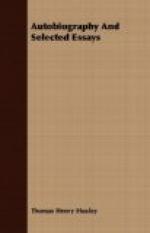ON THE ADVISABLENESS OF IMPROVING NATURAL KNOWLEDGE (1866)
[Footnote 19: On the Advisableness of Improving Natural Knowledge: from Method and Results: also published in Lay Sermons, Addresses and Reviews.]
For the history of the times mentioned in this essay, see Green’s Short History of the English People.]
[Footnote 20: The very spot: St. Martin’s Borough Hall and Public Library, on Charing Cross Road, near Trafalgar Square.]
[Footnote 21: Defoe (1661-1731): an English novelist and political writer. On account of his political writings Defoe was sentenced to stand in the pillory, and to be “imprisoned during the Queen’s pleasure.” During this imprisonment he wrote many articles. Later in life he wrote Robinson Crusoe, The Fortunes and Misfortunes of Moll Flanders, Journal of the Plague Year, and other books less well known.]
[Footnote 22: unholy cursing and crackling wit of the Rochesters and Sedleys: John Wilmot, the second Earl of Rochester, and Sir Charles Sedley, were both friends of Charles ii, and were noted for biting wit and profligacy. Green, in his Short History of the English People, thus describes them: “Lord Rochester was a fashionable poet, and the titles of some of his poems are such as no pen of our day could copy. Sir Charles Sedley was a fashionable wit, and the foulness of his words made even the porters in the Covent Garden belt him from the balcony when he ventured to address them.”]
[Footnote 23: Laud: Archbishop of Canterbury. Laud was born in 1573, and beheaded at London in 1645. He was throughout the reign of Charles I a staunch supporter of the King. He was impeached by the Long Parliament in 1640 and executed on Tower Hill, in 1645.]
[Footnote 24: selenography: the scientific study of the moon with special reference to its physical condition.]
[Footnote 25: Torricellian experiment: a reference to the discovery of the principle of the barometer by the Italian, Torricelli, in 1643.]
[Footnote 26: Sir Francis Bacon (1561-1626): Bacon endeavored to teach that civilization cannot be brought to a high point except as man applies himself to the study of the secrets of nature, and uses these discoveries for inventions which will give him power over his environment. The chief value of the work was that it called attention to the uses of induction and to the experimental study of facts. See Roger’s A Student’s History of Philosophy, page 243.]
[Footnote 27: The learned Dr. Wallis (1616-1703): Dr. Wallis is regarded as the greatest of Newton’s predecessors in mathematical history. His works are numerous and are on a great variety of subjects. He was one of the first members of the Royal Society.]
[Footnote 28: “New Philosophy”: Bacon’s ideas on science and philosophy as set forth in his works.]
[Footnote 29: Royal Society: see note, page 11.]




